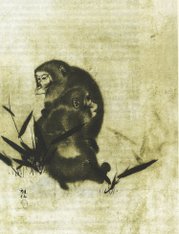Monkey
A monkey is any member of two of the three groupings of simian primates. These two groupings are the New World and Old World monkeys of which together there are nearly 200 species. Because of their similarity to monkeys, apes such as chimpanzees and gibbons are sometimes incorrectly called monkeys. more...
Also, a few monkey species have the word "ape" in their common name. Because they are not a single coherent group, monkeys do not have any important characteristics that they all share and are not shared with the remaining group of simians, the apes.
Monkeys range in size from the Pygmy Marmoset, at 10 cm (4 inch) long (plus tail) and 120 g (4 oz) in weight to the male Mandrill, almost 1 metre (3 ft) long and weighing 35 kg (75 lb). Some are arboreal (living in trees), some live on the savanna; diets differ among the various species but may contain any of the following: fruit, leaves, seeds, nuts, flowers, insects, spiders, eggs and small animals.
Some characteristics are shared among the groups; most New World monkeys have prehensile tails while Old World monkeys do not; some have trichromatic colour vision like that of humans, others are dichromats or monochromats. Although both the New and Old World monkeys, like the apes, have forward facing eyes, the faces of Old World and New World monkeys look very different though again, each group shares some features such as the types of noses, cheeks and rumps. To understand the monkeys, therefore, it is necessary to study the characteristics of the different groups individually.
The name monkey may come from a German version of the Reynard the Fox fable, published in around 1580. In this version of the fable, a character named Moneke is the son of Martin the Ape. The word Moneke may have been derived from the Italian monna, which means "a female ape." The name Moneke persisted over time likely due to the popularity of Reynard the Fox.
Monkeys in captivity
As pets
Generally, monkeys do not make good pets. They may appear to be nice and friendly and may resemble human babies for some people, but they should not be looked at as pets. While baby monkeys are usually as easy to keep clean as a human infant (by diapering), monkeys that have reached puberty usually remove their diapers and cannot be toilet trained. They require constant supervision and mental stimulation. They usually require a large amount of attention. Monkeys can not handle being away from their owners for long periods of times, such as family trips for example, due to their need of attention. Bored monkeys can become extremely destructive and may even go so far as to smear or throw their own feces. There needs to be a lot of time set aside for cleaning up whatever mess the monkey might make. Most adolescent monkeys begin to bite unpredictably and pinch adults and children. Any surgical means to stem this behavior (such removing the teeth or fingertips of the monkey) is widely considered cruel, and it is usually difficult to find veterinarians who will treat them: even exotic-animal veterinarians may not be familiar with them. The nice looking monkey eventually has to grow up and may in most cases become wild and not easy to control. The monkeys may also become aggressive even to their owners. They can change from one minute to the next without warning making it hard for the owner to fully understand them.
While a majority of monkey owners find other homes for them, such as zoos and monkey rescues, some people report having long and rewarding relationships with monkeys. Monkeys are known to get attached to their first owner so switching from one to another would not be a good idea. It is not easy for a monkey to get used to their new environment. Monkeys need to be placed in social areas. It might be bad for the monkey to place them in non-social areas which could lead to problems.It is not cheap to bring up a monkey. It becomes very costly when it comes to buying food and housing them. Some monkeys may even have special needs such as diets.
In most large metropolitan areas in the U.S. it is illegal to keep monkeys in the home; even in places where they are legal, a Department of Agriculture permit is usually required. Their legal status as pets varies in other countries. Permits may be issued to those who qualify in the caring of monkeys.
In laboratories
Macaques and African green monkeys are widely used in animal testing facilities because of their relative ease of handling and their psychological and physical similarity to humans. In the United States, around 50,000 non-human primates, most of them monkeys, have been used in experiments every year since 1973 (pdf); 10,000 monkeys were used in the European Union in 2004. Highly sociable animals, monkeys are kept in many different enviorments. There haven't been any reports of abuse so far with any of the research laboratories in the US.
Viktor Reinhardt, a former research veterinarian, wrote for the International Primate Protection League that: "he conditions I witnessed were so depressing that most monkeys had developed stereotypic behaviors such as pacing, rocking, bouncing, somersaulting, swaying from side to side, biting parts of their own bodies, pulling their ears, tossing their heads back and forth, or smearing feces on the cage walls." (mpg)
Read more at Wikipedia.org



![A macaque sits in a cage in a German laboratory. [1] A macaque sits in a cage in a German laboratory. [1]](pics/Monkey_3.jpg)
